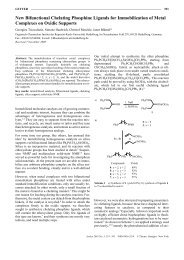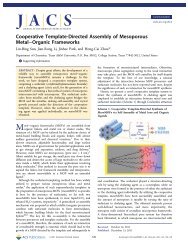Singlet Fission - Department of Chemistry
Singlet Fission - Department of Chemistry
Singlet Fission - Department of Chemistry
You also want an ePaper? Increase the reach of your titles
YUMPU automatically turns print PDFs into web optimized ePapers that Google loves.
AJ Chemical Reviews, XXXX, Vol. xxx, No. xx Smith and Michl<br />
high, as is the yield recently indirectly determined from<br />
ground-state bleach for a carotenoid aggregate by ps timeresolved<br />
resonance Raman spectroscopy 110 (section 4.1).<br />
These results make 8 the first successful compound<br />
purposely designed to exhibit efficient singlet fission, using<br />
the design principles outlined in section 2, although it is<br />
admittedly only accidental that the crystal structure <strong>of</strong> the<br />
C2 conformer <strong>of</strong> 8 contains slip-stacked pairs <strong>of</strong> molecules<br />
in an arrangement that appears to be nearly optimal for the<br />
direct mechanism <strong>of</strong> singlet fission based on the arguments<br />
made there (Figure 12). It is not presently certain that the<br />
same crystal structure is present in the film sublimed on<br />
sapphire.<br />
Triplet formation was also observed in polycrystalline<br />
solids <strong>of</strong> three dimers <strong>of</strong> 8 (30, 31, and 32), 82 presumably<br />
again due to singlet fission, because in cyclohexane solution<br />
these compounds exhibit no detectable triplet formation.<br />
These materials have not yet been examined in detail.<br />
3.5. Miscellaneous<br />
Perylene (9)<br />
The study <strong>of</strong> singlet fission in 9 is made particularly<br />
interesting by the fact that this hydrocarbon is available in<br />
two crystalline forms, R-9 and -9, the former <strong>of</strong> which<br />
forms excimers. Optically induced fission is a suitable probe<br />
for excimer formation because it provides information about<br />
whether the excimer forms on a faster time scale than<br />
vibrational relaxation and fission. 212,213 If it does, the excimerforming<br />
R form should exhibit a higher threshold energy<br />
for singlet fission due to the additional energy needed to<br />
break the excimer. This has been found to be the case. 138,212,213<br />
Using the magnetic field effect on prompt fluorescence as a<br />
function <strong>of</strong> excitation energy for an indicator, the threshold<br />
energy for R-9 is 3.51 eV, blue-shifted by 0.5 eV from the<br />
-9 threshold <strong>of</strong> 3.01 eV, 212 and one can conclude that in<br />
the R form excimer formation is faster than singlet fission.<br />
A theoretical estimate puts the rate <strong>of</strong> excimer formation at<br />
10 13 s -1 . 212 On the basis <strong>of</strong> the blue shift <strong>of</strong> the threshold<br />
energy in R-9, the binding energy for two triplets on<br />
neighboring molecules is 0.04 eV.<br />
<strong>Singlet</strong> fission has been observed in single crystals <strong>of</strong> 9<br />
(unspecified form, R or ) excited with vacuum UV radiation<br />
at energies higher than twice the triplet energy, as evidenced<br />
by magnetic field effects on the prompt fluorescence intensity.<br />
80 The fluorescence enhancement increased with increasing<br />
magnetic field strength before eventually saturating and<br />
was anisotropic with respect to magnetic field orientation.<br />
Tris-(8-hydroxyquinoline)aluminum (Alq3, 10)<br />
This material is <strong>of</strong> interest for use in organic light-emitting<br />
diodes (OLEDs), where it is <strong>of</strong>ten desirable to keep triplet<br />
formation as low as possible to produce light by fluorescence<br />
rather that phosphorescence. Because high current densities<br />
are commonly used, it is <strong>of</strong> interest to study triplet formation<br />
and decay under these conditions. At high excitation intensities,<br />
transient absorption signals in thin films <strong>of</strong> 10 121 show<br />
that excited singlets fuse to form higher excited singlets.<br />
Because <strong>of</strong> the prevalence <strong>of</strong> annihilation as a relaxation<br />
process for singlets under these conditions, the singlet<br />
population is proportional to Iex 1/2 . Triplets formed by singlet<br />
fission were also observed at high excitation intensities.<br />
Triplets formed by intersystem crossing have a density<br />
proportional to Iex 1/2 , whereas those formed by singlet fission<br />
have a density proportional to Iex. Thin films were excited<br />
with various intensities <strong>of</strong> 3.49 eV light. At Iex < 2 × 10 21<br />
photons cm -2 s -1 , intersystem crossing accounted for all<br />
triplet generation. At Iex > 2 × 10 22 photons cm -2 s -1 , the<br />
density <strong>of</strong> triplets is proportional to the excitation intensity.<br />
By subtracting the triplet density expected from intersystem<br />
crossing, the triplet quantum yield from singlet fission was<br />
determined to be 30%.<br />
Benzophenone (11)<br />
<strong>Singlet</strong> fission has been observed in single crystals <strong>of</strong> 11<br />
under two different excitation intensities using ps timeresolved<br />
absorption spectroscopy. 214 At lower excitation<br />
intensities, the triplet rise time equals the decay time <strong>of</strong><br />
excited singlet absorption, indicating that intersystem crossing<br />
is solely responsible for triplet formation. At four times<br />
higher excitation intensities, the total triplet rise time was<br />
faster than would be expected from intersystem crossing<br />
alone. A two-photon absorption to a highly excited singlet,<br />
followed by singlet fission, was consistent with the observed<br />
triplet formation. A good fit <strong>of</strong> the triplet rise time under<br />
high excitation intensity was obtained assuming that 40%<br />
<strong>of</strong> triplets are formed by fission.<br />
Rubrene (12)<br />
In a recent study <strong>of</strong> exciton diffusion in rubrene single<br />
crystals using photoconductivity measurements, long-lived<br />
excitons assigned as triplets were observed. <strong>Singlet</strong> fission<br />
was suggested as a possible source <strong>of</strong> these triplets, but no<br />
attempts to obtain direct evidence for singlet fission were<br />
made. 235<br />
4. Aggregates<br />
As crystal size diminishes, the relative importance <strong>of</strong><br />
surface molecules increases, and by the time nanocrystal size<br />
is reached, order tends to decrease. Very small nanocrystals<br />
are difficult to differentiate from molecular aggregates. The<br />
exact structure <strong>of</strong> such species is frequently known only<br />
approximately or not at all. The limiting cases are noncovalent<br />
dimers.<br />
With one exception, no singlet fission work seems to have<br />
been done on nanocrystals and aggregates. This is unfortunate,<br />
because one can easily imagine that they could be used<br />
as sensitizers on semiconductor nanoparticles in photovoltaic<br />
cells. The striking exception is the carotenoids, which occur<br />
naturally in the photosynthetic apparatus in the form <strong>of</strong><br />
aggregates and have been almost exclusively investigated<br />
for singlet fission in aggregates only.<br />
4.1. Carotenoids<br />
Carotenoids contain a series <strong>of</strong> linearly conjugated double<br />
bonds and can be viewed as oligomers on the way from<br />
ethylene and 1,3-butadiene to the simplest conjugated<br />
polymer, polyacetylene. As mentioned in section 2.2.2 and<br />
summarized in more detail in the introduction to section 5,<br />
in the usual all-anti configuration <strong>of</strong> such structures the<br />
lowest excited singlet electronic state S1 is the doubly excited<br />
2Ag - state that can be viewed as a singlet-coupled combination<br />
<strong>of</strong> triplet excitations localized in two different parts <strong>of</strong><br />
the chromophore. The strongly allowed 1Bu + HOMO-LUMO<br />
state that represents the usual optical entry into the excited



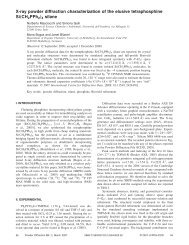
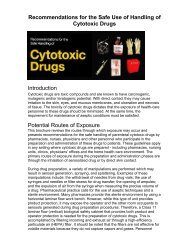
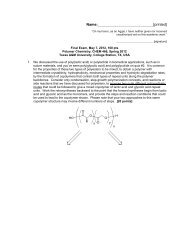

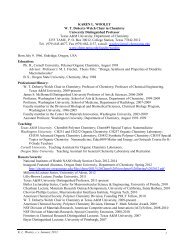
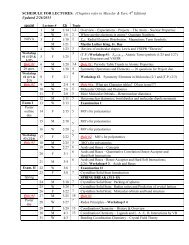
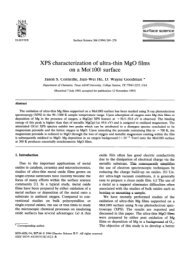
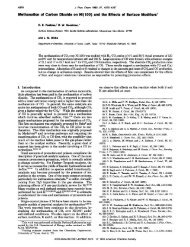
![Radical salts of TTF derivatives with the metal–metal bonded [Re2Cl8]](https://img.yumpu.com/10115211/1/190x253/radical-salts-of-ttf-derivatives-with-the-metal-metal-bonded-re2cl8.jpg?quality=85)



